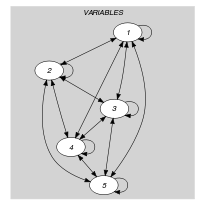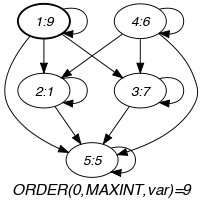5.265. minimum_modulo
| DESCRIPTION | LINKS | GRAPH |
- Origin
- Constraint
- Arguments
- Restrictions
- Purpose
is a minimum value of the collection of domain variables according to the following partial ordering: .
- Example
-
The constraints hold since is respectively set to values 6 and 9, where and are both less than or equal to all the expressions , , , , and .
- Typical
- Symmetry
Items of are permutable.
- Arg. properties
Functional dependency: determined by and .
- See also
-
specialisation: ( replaced by ).
- Keywords
characteristic of a constraint: modulo, maxint, minimum.
constraint arguments: pure functional dependency.
- Arc input(s)
- Arc generator
-
- Arc arity
- Arc constraint(s)
- Graph property(ies)
-
- Graph model
We use a similar definition that the one that was utilised for the constraint. Within the arc constraint we replace the condition by the condition .
Parts (A) and (B) of Figure 5.265.1 respectively show the initial and final graph associated with the second example of the Example slot. Since we use the graph property, the vertex of rank 0 (without considering the loops) associated with value 9 is outlined with a thick circle.
Figure 5.265.1. Initial and final graph of the constraint


(a) (b)